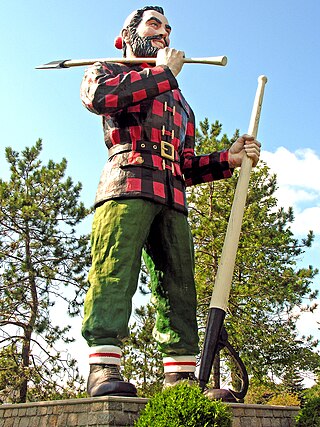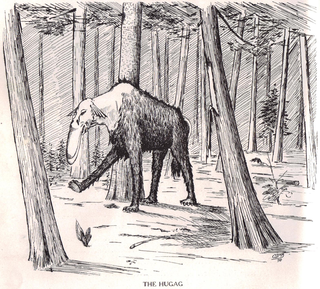United States
The tall tale has become a fundamental element of American folk literature. The tall tale's origins are seen in the bragging contests that often occurred when the rough men of the American frontier gathered. The tales of legendary figures of the Old West, some listed below, owe much to the style of tall tales.
The semi-annual speech-contests held by Toastmasters International public-speaking clubs may include a tall-tales contest. Each and every participating speaker is given three to five minutes to give a short speech of a tall-tale nature, and is then judged according to several factors. The winner proceeds to the next level of competition. The contest does not proceed beyond any participating district in the organization to the international level.
The comic strip Non Sequitur (1992–present) sometimes features tall tales told by the character Captain Eddie; it is left up to the reader to decide if he is telling the truth, exaggerating a real event, or fabricating a story entirely.
About real people
Some stories are told about exaggerated versions of real people:
- Johnny Appleseed – a friendly folk-hero who traveled the West planting apple trees because he felt his guardian angel told him to
- Johnny Blood – an American football player whose reputation for wild behavior was as well known as his on-field play
- Jim Bowie – A Kentuckian frontiersman, Texas Ranger, and land speculator who fought for the Texan cause in the Battle of the Alamo. He is known for the Bowie knife which he used to disembowel opponents.
- Daniel Boone – blazed a trail across Cumberland Gap to found the first English-speaking colonies west of the Appalachian Mountains
- Aylett C. "Strap" Buckner – an Indian fighter of colonial Texas [1]
- Annie Christmas – a Louisiana keelboat captain, who in real life was white, but in folklore and tall tales was turned into an African-American supernaturally strong woman who defied the gender norms of the time.
- Davy Crockett – a pioneer and U.S. Congressman from Tennessee who later died at the Battle of the Alamo
- Mike Fink – the toughest boatman on the Ohio and Mississippi rivers, and a rival of Davy Crockett. Also known as the King of the Mississippi River Keelboatmen.
- Peter Francisco – American Revolutionary War hero
- John Henry – a mighty steel-driving African American
- Calamity Jane – a tough Wild-West woman
- Jigger Johnson (1871–1935), a lumberjack and log driver from Maine who is known for his numerous off-the-job exploits, such as catching bobcats alive with his bare hands, and drunken brawls [2] [3]
- Casey Jones – a brave and gritty railroad engineer
- Nat Love, also known as "Deadwood Dick", was born a slave in Tennessee in 1854. Tales of his adventures after emancipation, as a cowboy and as a Pullman porter, gained such fantastical elements as to be considered tall tales
- Sam Patch – an early 19th-century daredevil who died during a jump on Friday the 13th
- Molly Pitcher – a heroine of the American Revolutionary War
- Blackbeard spawned various tall tales surrounding his involvement with piracy from 1717–1718
About imaginary people

Subjects of some American tall tales include legendary figures:
- Paul Bunyan – huge lumberjack who eats 50 pancakes in one minute, dug the Grand Canyon with his axe, made Minnesota's ten thousand lakes with his footprints, and also has a blue ox named Babe who made the Mississippi River
- Tony Beaver – a West Virginia lumberjack and cousin of Paul Bunyan
- Pecos Bill – legendary cowboy who "tamed the wild west"
- Cordwood Pete – younger brother to lumberjack Paul Bunyan
- Febold Feboldson – a Nebraska farmer who could fight a drought
- Johnny Kaw, a fictional Kansan whose mythological status itself was in one sense a figment, in that it was created recently, in 1955. Adherents of this assessment deem such stories fakelore.
- Joe Magarac – a Pittsburgh steelworker made of steel
- Alfred Bulltop Stormalong – an immense sailor whose ship was so big that it scraped the Moon












